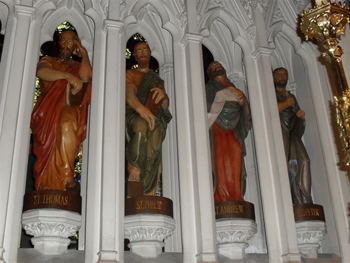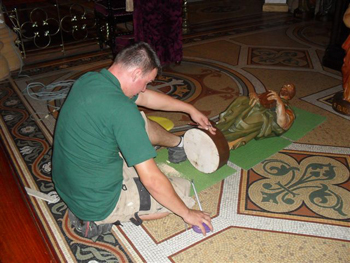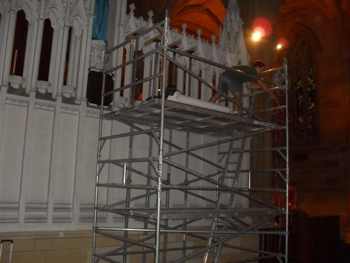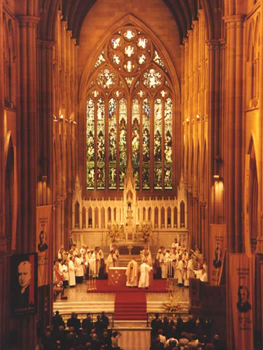2013
VATICAN : CARDINALS SEND NOTE OF THANKS TO BENEDICT XVITODAY'S SAINT : MARCH 5 : ST. JOHN JOSEPH OF THE CROSSCARDINALS SEND TELEGRAM OF GRATITUDE TO BENEDICT XVIVatican City, 5 March 2013 (VIS) – Fr. Federico Lombardi, S.J., director of the Holy See Press Office, in this afternoon's press conference, gave updated information on the development of the General Congregations. (IMAGE SOURCE: RADIO VATICANA) “On Monday afternoon from 5:00pm until 7:00pm,” he said, “the second General Congregation of the College of Cardinals took place, during which Fr. Raniero Cantalamessa, OFM Cap., preacher of the Pontifical Household, gave the first of the meditations provided for by the Apostolic Constitution.” “Additionally, a further five Cardinal electors who had arrived in Rome swore the oath: Cardinal Bechara Boutros Rai, O.M.M., patriarch of Antioch of the Maronites, Lebanon; Cardinal Joachim Meisner, archbishop of Cologne, Germany; Cardinal Rainer Maria Woelki, archbishop of Berlin, Germany; Cardinal Théodore-Adrien Sarr, archbishop of Dakar, Senegal; and Cardinal Dominik Jaroslav Duka, O.P., archbishop of Prague, Czech Republic.” The cardinals are free to address the gathering, having only to sign up and then presenting in the order that they have signed in. Nine cardinals spoke and it was also decided that, on Tuesday and Wednesday, the Congregations will only be held in the morning. Referring to the third Congregation that took place this morning from 9:30am until 12:40pm, Fr. Lombardi reported that two Cardinal electors—Cardinal Antonio Maria Rouco Varela, archbishop of Madrid and Cardinal Zenon Grocholewski, prefect emeritus of the Congregation for Catholic Education—and five cardinals who are over the age of 80 arrived and swore the oath. In total there were 148 cardinals present. There were 11 speeches given by cardinals representing each of the continents and the topics discussed were: activities of the Holy See and its relations with bishops throughout the world; Church renewal in light of Vatican Council II; the Church's position and the need for the New Evangelization in today's world with its diverse cultural environments. Number 37 of Benedict XVI's Motu Proprio concerning the beginning of the Conclave was presented to the prelates but no decision regarding its date was made. There was also a proposal, endorsed by the Particular Congregation, to dedicate tomorrow afternoon to prayer in St. Peter's Basilica. The Cardinal Dean, Angelo Sodano, will lead the prayers. This initiative will also serve as an invitation to the entire Church to pray at this important moment. The ceremony is open to the public so any faithful who so desire may attend. In conclusion, the text of a telegram for Pope Emeritus Benedict XVI, which was signed by Cardinal Dean Sodano, was approved. It reads: “To His Holiness, Pope Emeritus Benedict XVI, Castel Gandolfo.” “The Cardinal Fathers, gathered at the Vatican for the General Congregations in view of the next conclave, send you their devoted greetings and express their renewed gratitude for all your illustrious Petrine ministry and for your example of generous pastoral care for the good of the Church and of the world. With their gratitude they hope to represent the recognition of the entire Church for your tireless work in the vineyard of the Lord. In conclusion, the members of the College of Cardinals trust in your prayers for them, as well as for the whole Church.” Fr. Lombardi reported that the preparations for the Conclave have begun in the Sistine Chapel so it is now closed to visitors. He also presented data on the media coverage of the events of the Holy See in these days: 4,432 temporarily accredited journalists have joined the 600 permanently accredited journalists. The more than 5,000 journalists represent 1,004 news outlets, 65 nations, and 24 languages. |
| NEW CHALICE-URNS FOR ELECTION OF POPE Vatican City, 5 March 2013 (VIS) – On a tapestry hanging in the eponymous gallery of the Vatican Museums, we find one of the oldest witnesses of the chalice-urns that served to gather the ballots of the cardinals voting in the election of a new pontiff. The tapestry relates an episode narrated in the chronicles of the election of Pope Urban VIII (1623-1644). In the final scrutiny, during the counting of the ballots, one ballot was missing. On the right-hand side of the tapestry, one can see a scrutineer who is looking inside a large chalice with attention and interest, as if to verify the presence of the lost ballot. A chalice that is very similar to the one seen in the tapestry and a pyx (ciborium) are preserved in the pontifical sacristy of the Sistine Chapel. This chalice and pyx have been used to gather the voting ballots in the conclaves of the last century, up to the election of John Paul II. With the promulgation of the Apostolic Constitution "Universi Dominici Gregis" concerning the period of Sede Vacante of the Apostolic See and the election of the Roman Pontiff (John Paul II, 22 February 1996), the need arose to adapt the urns to the new norms. It was necessary to add a new urn to the chalice and pyx called for in previous regulations, in order to receive the votes of any cardinals having the right to vote but who were impeded through illness from leaving their room to be present for the voting process in the Sistine Chapel. Rather than creating another urn, three new ones were designed during John Paul II's pontificate, principally to make them more functional for the intended use, but also to make them uniform. The function of the urns is described in Chapter V of the Constitution, which also speaks of a plate to be placed on top of the first urn. Every cardinal, in fact, must "place his ballot on the plate, with which he drops it into the receptacle beneath." The second urn will be used only in the case of the presence in the Conclave of cardinals impeded by illness from leaving their rooms and the third urn will be used to gather the ballots after the scrutiny, before they are burned to produce the traditional smoke announcing to the faithful gathered in St. Peter's Square either the non-election (black smoke) or the election (white smoke) of the new Pontiff. The urns are the work of the Italian sculptor Cecco Bonanotte, already known for the new entrance doors of the Vatican Museums that were inaugurated on the occasion of the Jubilee Year 2000. They are made of silver and gilded bronze and their iconography is linked to two fundamental symbols: the first is that of the Good Shepherd and the second of charity. The symbols chosen by the artist for the three urns—a shepherd and his sheep along with more subtle birds, grapes, and ears of grain—are united in a simple and direct way to the meaning that the person of the Pope has in the Church: the shepherd, indeed the Good Shepherd who, in the name of Christ, has the duty of "confirming his brothers" (Luke 22:31) in the faith. The symbolism of the Good Shepherd, however, also underlines the style of exercising this primacy, which is indissolubly linked to charity. This idea is clearly expressed in the Gospel of John (21:15-25) where "feeding" the flock is joined inseparably to loving care: "Simon of John, do you love me?..." Peter tells him: "Lord, you know everything, you know that I love you: "Feed my lambs." The relationship of love between Jesus and Peter, and as a consequence between the Pope and the Church, is emphasized in the other symbols used to decorate the urns: the birds, grapes, and the ears of grain. Eucharistic bread and wine, which are Christ, accentuate the idea of charity underlined by the sharing of this very bread and the chalice. |
AFRICA : LIBYA : GUNMAN TRY TO KILL TWO PRIESTS
ASIA NEWS REPORT
Islamists try to lynch Fr Paul Isaac, an Egyptian Coptic Orthodox priest, and his assistant. Although the incident occurred on 3 February, it was only reported last night. This is the third attack against the country's Christian community. The Libyan government condemns the attack, calling it an attack against Islam.
_0503_-_Copti.jpg) Benghazi (AsiaNews) - Islamic militiamen attacked Benghazi's Coptic Orthodox Church on 3 February. During the incident in the capital of Cyrenaica, the gunmen assaulted two clergymen, Fr Paul Isaac and his assistant, whose name was not released, state-ownedLibyan News Agency (LANA) reported last night.
Benghazi (AsiaNews) - Islamic militiamen attacked Benghazi's Coptic Orthodox Church on 3 February. During the incident in the capital of Cyrenaica, the gunmen assaulted two clergymen, Fr Paul Isaac and his assistant, whose name was not released, state-ownedLibyan News Agency (LANA) reported last night.
The foreign ministry said it "strongly condemned Thursday's attack on the Egyptian church" and expressed "deep concern" over the attack, saying it was "contrary to the rules" of Islam.
Benghazi's Coptic community has not yet made any public statement on the matter. Speaking to AsiaNews, local Copts said that the community chose silence fearing more attacks.
In December, an explosion at a building belonging to a Coptic church in Dafniya, close to the western city of Misratah, killed two Egyptian men and wounded two others.
In another case of anti-Christian persecution, 48 Egyptian peddlers were arrested in Benghazi last Thursday on suspicion of proselytising. Eventually, 20 were sent home after Egyptian authorities intervened.
Also last month, four foreigners, an Egyptian, a South African, a Korean and a Swede who was travelling on a US passport, were arrested in Benghazi on suspicion of being Christian missionaries and printing books about Christianity. They are now in prison in Tripoli waiting for trial.
With the fall of Muammar Gaddafi, killed in October 2011, Libya has turned into a hub for radical Muslim groups and militias from across the Middle East and North Africa.
Catholic religious orders have also been targeted by Muslim extremists despite operating in the country for decades in hospitals and nursing homes.
For example, in January Islamists forced the Ursuline Sisters of the Sacred Heart of Jesus out of the city of Bayda.
In October, the same thing happened to the Sisters of the Convent of the Sacred Family of Spoleto in Derna who felt they had to leave the city even though local residents wanted them to stay. (S.C.)
SHARED FROM ASIA NEWS IT
Islamists try to lynch Fr Paul Isaac, an Egyptian Coptic Orthodox priest, and his assistant. Although the incident occurred on 3 February, it was only reported last night. This is the third attack against the country's Christian community. The Libyan government condemns the attack, calling it an attack against Islam.
_0503_-_Copti.jpg) Benghazi (AsiaNews) - Islamic militiamen attacked Benghazi's Coptic Orthodox Church on 3 February. During the incident in the capital of Cyrenaica, the gunmen assaulted two clergymen, Fr Paul Isaac and his assistant, whose name was not released, state-ownedLibyan News Agency (LANA) reported last night.
Benghazi (AsiaNews) - Islamic militiamen attacked Benghazi's Coptic Orthodox Church on 3 February. During the incident in the capital of Cyrenaica, the gunmen assaulted two clergymen, Fr Paul Isaac and his assistant, whose name was not released, state-ownedLibyan News Agency (LANA) reported last night.The foreign ministry said it "strongly condemned Thursday's attack on the Egyptian church" and expressed "deep concern" over the attack, saying it was "contrary to the rules" of Islam.
Benghazi's Coptic community has not yet made any public statement on the matter. Speaking to AsiaNews, local Copts said that the community chose silence fearing more attacks.
In December, an explosion at a building belonging to a Coptic church in Dafniya, close to the western city of Misratah, killed two Egyptian men and wounded two others.
In another case of anti-Christian persecution, 48 Egyptian peddlers were arrested in Benghazi last Thursday on suspicion of proselytising. Eventually, 20 were sent home after Egyptian authorities intervened.
Also last month, four foreigners, an Egyptian, a South African, a Korean and a Swede who was travelling on a US passport, were arrested in Benghazi on suspicion of being Christian missionaries and printing books about Christianity. They are now in prison in Tripoli waiting for trial.
With the fall of Muammar Gaddafi, killed in October 2011, Libya has turned into a hub for radical Muslim groups and militias from across the Middle East and North Africa.
Catholic religious orders have also been targeted by Muslim extremists despite operating in the country for decades in hospitals and nursing homes.
For example, in January Islamists forced the Ursuline Sisters of the Sacred Heart of Jesus out of the city of Bayda.
In October, the same thing happened to the Sisters of the Convent of the Sacred Family of Spoleto in Derna who felt they had to leave the city even though local residents wanted them to stay. (S.C.)
SHARED FROM ASIA NEWS IT
AMERICA : PANAMA : CALL FOR PEACEFUL ELECTIONS
Agenzia Fides REPORT - The Catholic Church has re-launched its appeal to all political parties to sign the Panamanian electoral ethical pact to prevent violence and ensure peaceful and transparent elections in May 2014 (see Fides 31/01/2013). The last date of signature expires on March 6.
His Exc. Mgr. José Domingo Ulloa, Archbishop of Panama, one of the main supporters of the pact, insisted that the signing of this document, prepared by the Panamanian Episcopal Conference, and submitted through the Commission for Justice and Peace, is a means to create a climate of trust, security and electoral transparency.
The Archbishop was very direct and determined by inviting the citizens to refrain from providing support to candidates who are more interested in destroying or smearing the opponent and to support series proposals for the common good. He also urged the media and the civil authorities to commit themselves to creating an electoral environment where the respect of human dignity prevails. The ruling party has not yet signed the pact. (CE)
His Exc. Mgr. José Domingo Ulloa, Archbishop of Panama, one of the main supporters of the pact, insisted that the signing of this document, prepared by the Panamanian Episcopal Conference, and submitted through the Commission for Justice and Peace, is a means to create a climate of trust, security and electoral transparency.
The Archbishop was very direct and determined by inviting the citizens to refrain from providing support to candidates who are more interested in destroying or smearing the opponent and to support series proposals for the common good. He also urged the media and the civil authorities to commit themselves to creating an electoral environment where the respect of human dignity prevails. The ruling party has not yet signed the pact. (CE)
AUSTRALIA : 16 NEW STATUES IN CATHEDRAL
Catholic Communications, Sydney Archdiocese REPORT
5 Mar 2013
5 Mar 2013

Statues of St Thomas, St Andrew, St Philip and St Peter and the Apostles
A team of heritage stone masons have spent the past six days installing 16 specially-commissioned hand-carved painted statues in the reredos, the ornate stone screen, behind the high altar at St Mary's Cathedral.
The 17 niches in the elaborately carved stone reredos were always meant to be filled with depictions of the Apostles, St Paul, John the Baptist and the two Biblical prophets, Elijah and Moses, and were part of architect, William Wardell's original vision for the Cathedral.
But for 133 years the niches in the reredos remained empty except for the central niche where Wardell and Bishop John Bede Polding had installed an exquisite statue of Our Lady Help of Christians, patron saint of Australia.
No one is sure why the niches in the reredos were never filled and one of the legends has it that they were ordered from European ecclesiastical sculptors but went down in the ship carrying them to Australia.

One of the stone masons prepares a statue for installation in the reredos
Now after almost a century and a half, Wardell's dream for the Cathedral is about to be realised with the final statue, one of Elijah set to be installed later today.
Commissioned by the Archbishop of Sydney, Cardinal George Pell and made possible by donations from the Friends of the Cathedral, the Australian Catholic University (ACU) and Damian Fogarty, the statues were created by sculptors, carvers, painters and leading ecclesiastical artisans at Spain's famous Talleres de Arte Grandas workshop.
Each one is a work of art in its own right. Arriving from Spain in late December the statues were carefully unpacked and six weeks ago went on display in the Lady Chapel to enable Sydneysiders to have a close up view of these latest treasures prior to their installation in the ornate reredos behind the high altar.
Since his arrival in Sydney in 2001, the Cardinal has done much to complete Wardell and Bishop Polding's original vision for the Cathedral as well as instigating the conservation, repair, cleaning and restoration of the Cathedral's paintings, artefacts and sculptures. His Eminence also began an ongoing conservation, cleaning and restoration program for St Mary's magnificent sandstone interior and exterior walls.

Installation of the statues in the Cathedral reredos needed special care
In addition, Cardinal Pell has commissioned and overseen several important new works at the Cathedral including the altar triptych by British master sculptor Nigel Boonham and the superb statue of Australia's first saint, St Mary of the Cross MacKillop by Melbourne-based sculptor Louis Laumen which stands on the steps of the Cathedral's Western Transept in College Street.
Of the new wooden handpainted statues, two of the Biblical prophets are larger than the others and are designed to stand in the taller niches which flank each side of the reredos.
The team of stone masons have been hard at work on the installation of the 16 statues since Thursday last week.
"Moses, the Apostles, John the Baptist and St Paul are now in place and being secured. Then later today the final statue among the 16, one of the prophet Elijah will be installed," says Dieter Koch, Property Officer for the Archdiocese of Sydney.

The Cathedral's main altar and reredos with its empty niches
Tomorrow will be spent on clean up and final touches and by Thursday, William Wardell's dream will be realised at last.
SHARED FROM ARCHDIOCESE OF SYDNEY
TODAY'S GOSPEL ONLINE : TUES. MARCH 5, 2013
Matthew 18: 21 - 35 | |
| 21 | Then Peter came up and said to him, "Lord, how often shall my brother sin against me, and I forgive him? As many as seven times?" |
| 22 | Jesus said to him, "I do not say to you seven times, but seventy times seven. |
| 23 | "Therefore the kingdom of heaven may be compared to a king who wished to settle accounts with his servants. |
| 24 | When he began the reckoning, one was brought to him who owed him ten thousand talents; |
| 25 | and as he could not pay, his lord ordered him to be sold, with his wife and children and all that he had, and payment to be made. |
| 26 | So the servant fell on his knees, imploring him, `Lord, have patience with me, and I will pay you everything.' |
| 27 | And out of pity for him the lord of that servant released him and forgave him the debt. |
| 28 | But that same servant, as he went out, came upon one of his fellow servants who owed him a hundred denarii; and seizing him by the throat he said, `Pay what you owe.' |
| 29 | So his fellow servant fell down and besought him, `Have patience with me, and I will pay you.' |
| 30 | He refused and went and put him in prison till he should pay the debt. |
| 31 | When his fellow servants saw what had taken place, they were greatly distressed, and they went and reported to their lord all that had taken place. |
| 32 | Then his lord summoned him and said to him, `You wicked servant! I forgave you all that debt because you besought me; |
| 33 | and should not you have had mercy on your fellow servant, as I had mercy on you?' |
| 34 | And in anger his lord delivered him to the jailers, till he should pay all his debt. |
| 35 | So also my heavenly Father will do to every one of you, if you do not forgive your brother from your heart." |
TUESDAY, MARCH 5, 2013
TODAY'S SAINT : MARCH 5 : ST. JOHN JOSEPH OF THE CROSS
St. John Joseph of the Cross
CONFESSOR
Feast: March 5
Information:
|
Born on the Island of Ischia, Southern Italy, 1654; d. 5 March, 1739. From his earliest years he was given to prayer and virtue. So great was his love of poverty that he would always wear the dress of the poor, though he was of noble birth. At the age of sixteen years he entered the Order of St. Francis at naples, amongst the Friars of the Alcantarine Reform, being the first Italian to join this reform which had been instituted in Spain by St. Peter of Alcantara. Throughout his life he was given to the greatest austerity: he fasted constantly, never drank wine, and slept but three hours each night. In 1674 he was sent to found a friary at Afila, in Piedmont; and he assisted with his own hands in the building. Much against his will, he was raised to the priesthood. As superior, he always insisted upon performing the lowliest offices in the community. In 1702 he was appointed Vicar Provincial of the Alcantarine Reform in Italy. He was favoured in a high degree with the gift of miracles, people of every condition being brought to him in sickness. His zeal for souls was such that even in sickness he would not spare any labour for them. His great devotion was to our Blessed Lady, and he was urgent with his penitents that they also should cultivate this. He was beatified in 1789, and canonized in 1839.
(Taken From Catholic Encyclopedia)
|
source: http://www.ewtn.com/saintsHoly/saints/J/stjohnjosephofthecross.asp#ixzz1oFCCyNuO

No comments:
Post a Comment